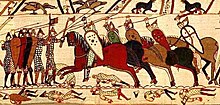Standard


A special form of the flag is referred to as a standard (from old French estandart , old Franconian location "place of installation") in vexillology (flagology) and heraldry (heraldry) .
use
Official standards are emblems of a head of state , a head of government , the heads of other state organs or the armed forces and diplomatic representatives of a state . They show the public where this person is and therefore cannot be used by anyone.
Car stand
A well-known example are car stands on state cars , which carry high representatives of a state, including the diplomatic corps, on relevant occasions. For this purpose, the stands are attached to two standard holders on the fenders . For federal state funerals (e.g. Federal President), federal mourning standards are set in Germany (silver federal eagle on a black background with a dark blue border, 30 × 30 cm).
Standard on the vehicle of the German Federal President
Standard of the Czech President
history

The script was originally in ancient times a gehisstes on a pole field characters , usually a picture, which the gathering place of a military unit selected in the battle and so the Insignia was this military unit. From the original Signa , mostly animal images, the Aquila , the eagle, was transferred to the legions as a standard, while the manipulus became the standard for the manipulas and the vexillum for the cavalry as a flag . The (today's) banner is derived from the latter .
In the Holy Roman Empire, the royal banner in particular was called an imperial standard , and since around 1800 the name has generally been used for the personal flag of a regent or other members of a ruling house.
In the early Middle Ages of heavy knight armies, this standard was permanently mounted on a chariot, in the late Middle Ages, when faster cavalry emerged, also as an elongated, one or two-pronged equestrian flag , then as a square banner with a pennant , since the 17th century a mostly square, later also triangular flag of mounted troops of all kinds. At the beginning of the 20th century it was passed on to the successors of the cavalry, the mobile motorized troops .
See also
literature
- Andreas Herzfeld: The Rimann'sche collection of German car flags and car stands. Volume 2: Germany since 1945 (= contributions to German automobile history. Volume 3). German Society for Flag Studies, Berlin 2009, ISBN 978-3-935131-09-4 .
Web links
Individual evidence
- ↑ Festschrift for the 150th anniversary of the Herold zu Berlin ( HEROLD Association for Heraldry, Genealogy and Allied Sciences) . In: Herold-Jahrbuch 2019 . Michael Zander: The federal mourning standard as an example of German state symbolism , p. 349 mwN and Fig. 23 nF Selbstverlag, Berlin 2019.
- ↑ flag [1] . In: Meyers Großes Konversations-Lexikon . Volume 6. Leipzig 1906, pp. 267-268. ( Online at zeno.org).






